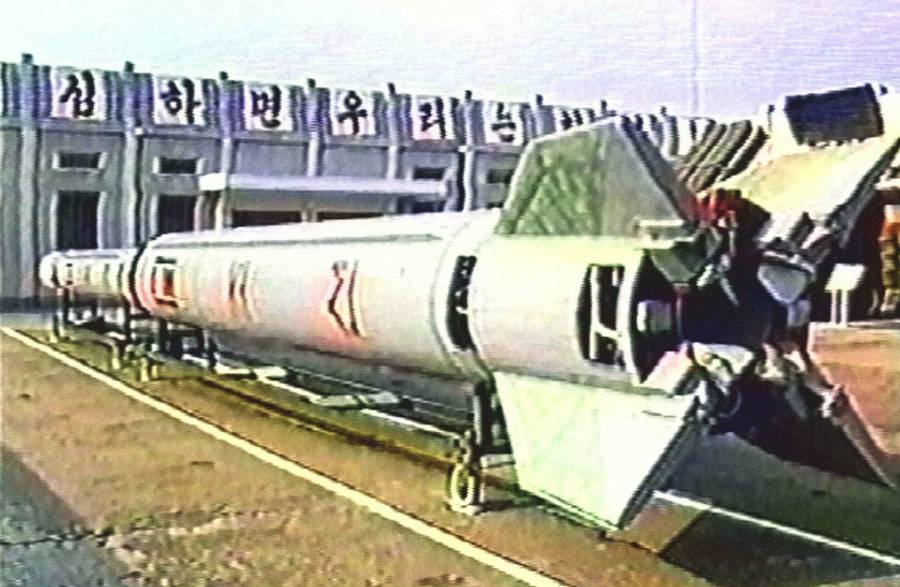- California Assembly OKs highest minimum wage in nation
- S. Korea unveils first graphic cigarette warnings
- US joins with South Korea, Japan in bid to deter North Korea
- LPGA golfer Chun In-gee finally back in action
- S. Korea won’t be top seed in final World Cup qualification round
- US men’s soccer misses 2nd straight Olympics
- US back on track in qualifying with 4-0 win over Guatemala
- High-intensity workout injuries spawn cottage industry
- CDC expands range of Zika mosquitoes into parts of Northeast
- Who knew? ‘The Walking Dead’ is helping families connect
N. Korean missiles could reach US mainland: S. Korea
SEOUL (Yonhap) — North Korea appears to have achieved “a significant level” of technology to miniaturize nuclear warheads to fit on its ballistic missiles that could potentially reach the United States mainland, South Korea’s defense ministry said Tuesday.
The assessment was included in the 2014 edition of the ministry’s biennial white paper released on the day, which highlights North Korea’s evolving nuclear and missiles threats to the region and beyond after its third and most recent nuclear test in 2013.
It was the first time that the paper carried a technological analysis of the North’s nuclear program, with the previous edition simply outlining the country’s two underground detonation tests conducted in 2006 and 2009.
“North Korea’s capabilities of miniaturizing nuclear weapons appear to have reached a significant level,” the paper said. “North Korea is presumed to have secured some 40 kilograms of weapons-grade plutonium by reprocessing spent nuclear fuel roads multiple times, and it is evaluated to have been working on the highly enriched uranium program.”
Pyongyang has yet to demonstrate the miniaturization capability, though officials and experts from South Korea and the U.S. have said the communist country is believed to have the technology to build nuclear-tipped missiles.
“We don’t have any intelligence that North Korea completed the miniaturization. In consideration of the fact that acquiring such technology takes around two to seven years in general and eight years have passed since the North conducted its first nuclear test, however, its capability for small nuclear warheads would have reached a significant level,” a ministry official said, requesting anonymity.
In the paper, South Korea also assessed that North Korea is “presumed to have (missiles) capabilities that could threaten the U.S. mainland, having fired off long-range missiles five times.”
The evaluation was based upon the North’s successful sending of a satellite into orbit on an Unha-3 long-range rocket in December 2012, according to the official, noting that its Taepodong-2 long-range rocket is believed to have a range of 10,000 kilometers.
Despite Pyongyang’s push to develop long-range missiles, no signs have been detected that Pyongyang has put them into service, he added.
In an apparent move to strengthen defenses along the border and to better protect its military facilities, North Korea has set up a new corps-scale military unit in its North Hamkyong Province upon the instruction of its leader Kim Jong-un, according to the defense paper. The establishment has raised the total number of the North’s regular corps to 10.
As of October 2014, North Korea had 1.2 million regular service personnel, some 10,000 more than two years ago, while South Korea has around 630,000 service members, the paper said.
The communist country has also continued its military build-up by securing more armored vehicles, rocket launchers and battleships, and it is presumed to be building new types of submarines such as one capable of firing ballistic missiles.
In the face of such growing threats from the bellicose regime, South Korea defined the North Korean regime and its military as South Korea’s “enemy” in the paper as the communist country has posed “serious threats to our national security.”
South Korea had dropped the definition in 2004 after 10 years of use, but revived the expression in its 2012 white paper after the North carried out a series of military provocations in 2010 including torpedoing the South Korean naval corvette Cheonan, killing 46 sailors, and shelling the western sea border island of Yeonpyeong, killing four.
The two Koreas are still technically at war because the 1950-53 Korean War ended in a truce, not a peace treaty.
Meanwhile, South Korea vowed “stern responses” to Japan’s claims to its own territory, reaffirming its commitment to the country’s easternmost islets of Dokdo in the East Sea to protect its sovereignty.
“The regressive historical conception by some Japanese political leaders and its unjustified territorial claims to Dokdo have served as a stumbling block for the future-oriented development of bilateral relations,” the paper said.
“The defense ministry will continue to sternly deal with Japan’s unjustified claims to Dokdo, while cooperating further on major security issues such as North Korea’s nuclear threats for peace and stability in Northeast Asia,” it noted.
South Korea sees Japan’s territorial claim to Dokdo as tantamount to the denial of its independence. Seoul reclaimed sovereignty over all of its territory — including Dokdo and many other islands around the Korean Peninsula — upon its independence from Japan in 1945.
The full version of the comprehensive white paper is available at the defense ministry’s website (www.mnd.go.kr), with the English version due out around May, according to its officials.
















